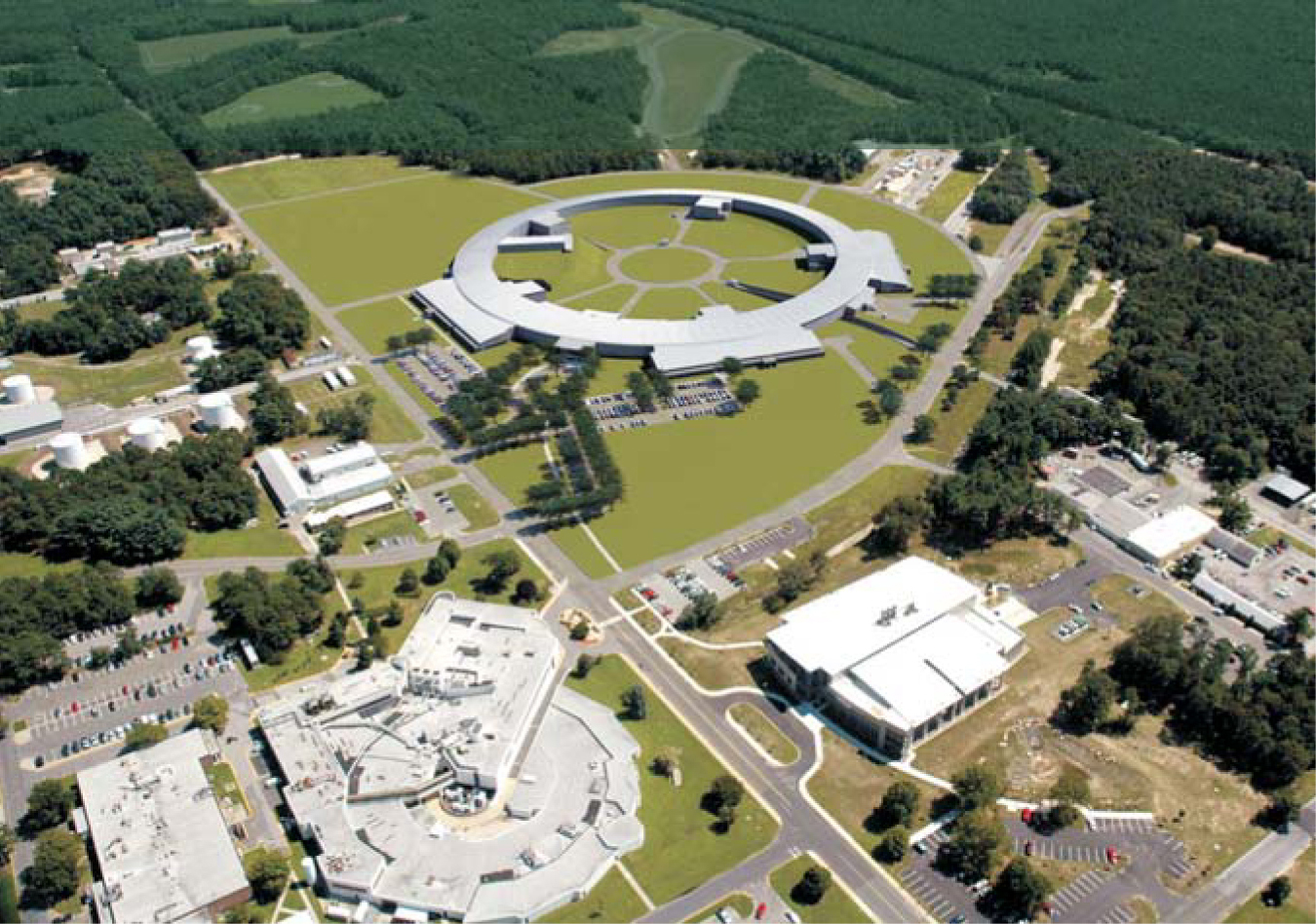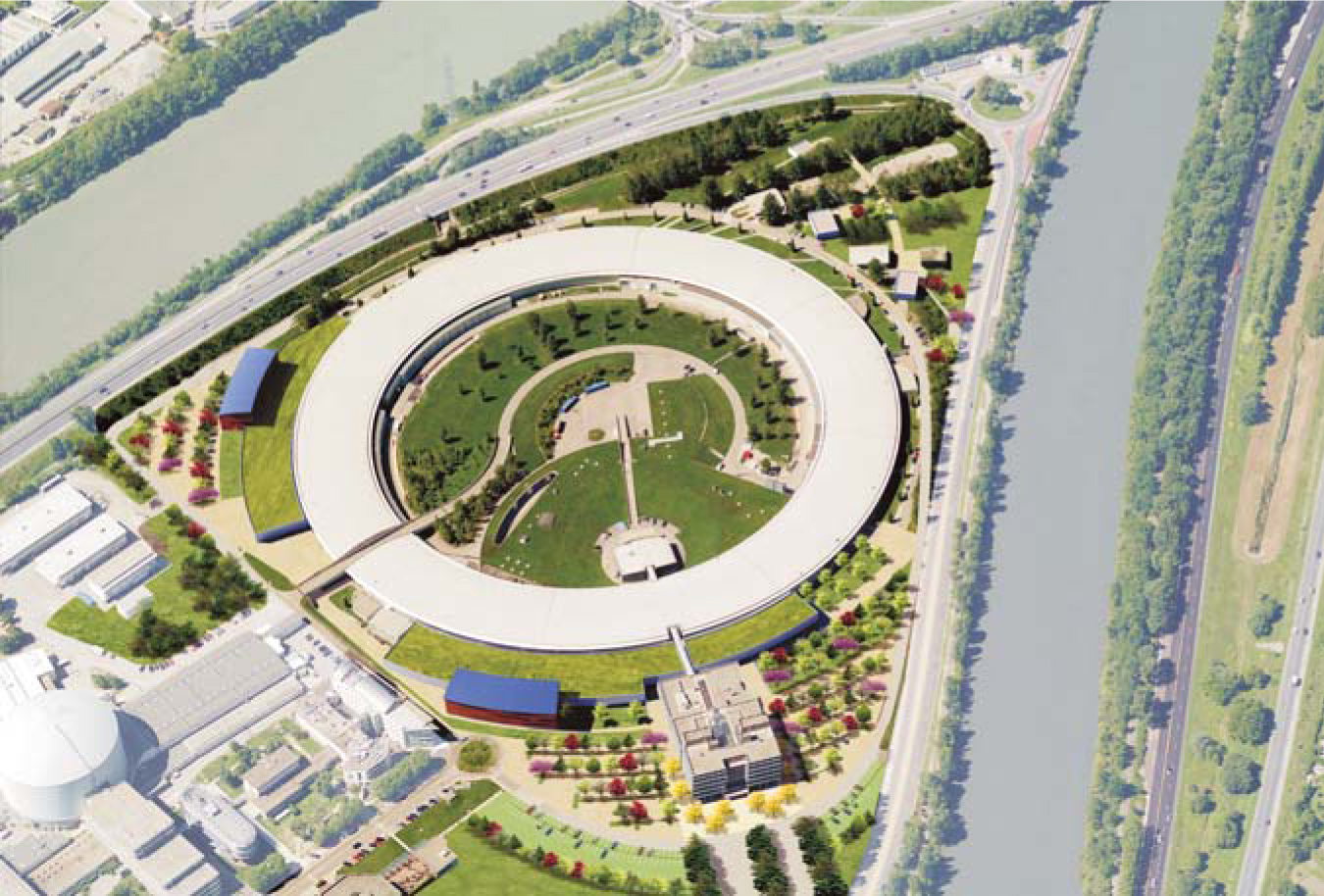Brookhaven light source to brighten x-ray beams
DOI: 10.1063/1.3099571
The US Department of Energy (DOE) has given the okay to begin construction of a $912 million light source that will breathe new life into Brookhaven National Laboratory (BNL) and establish the Long Island facility as a powerhouse for nanotechnology. The second National Synchrotron Light Source, scheduled for completion in 2015, will produce 3-GeV beams that are 10 000 times brighter than the 27-year-old BNL machine it will replace. Using that bright, tightly focused light, researchers hope to achieve the nanometer-scale spatial resolution they need to reveal the structures of highly complex proteins and other biological molecules, develop new and more efficient catalysts, and invent the next generation of computer chips.
The nod to NSLS-II came two months after the announcement of a seven-year, €178 million ($230 million) upgrade program for the European Synchrotron Radiation Facility in Grenoble, France. That project is aimed at maintaining the ESRF’s status among the brightest sources of experimental x rays in the world.
Currently the most expensive of the construction projects under way at the 10 national laboratories that are operated by DOE’s Office of Science, NSLS-II had been considered a long-term priority among the major new scientific facilities under consideration by the agency as recently as 2003 (see Physics Today, January 2004, page 23
The project still must overcome a shortfall in funding resulting from congressional inaction on appropriations for the current fiscal year. BNL has received just $21.5 million of the $103 million that DOE requested for NSLS-II. If no further funding is provided in FY 2009—a real possibility—construction could be delayed by more than six months, and project costs will increase, warns Steven Dierker, BNL associate director and project manager.
Synchrotron light sources attract about 50 000 researchers a year from a broad array of disciplines and fields, including materials science, structural biology, geology, and paleontology. More than 20 sources worldwide have opened for business since 1994, when the ESRF came on line. This year China is set to finish construction of its Shanghai Synchrotron Radiation Facility, the nation’s largest science project, and a new machine is scheduled to open in Germany. Spain will open its first in 2010. In the US, DOE maintains four light sources, with universities offering a number of smaller ones.
Among a select few
The NSLS-II will have the most brilliant beam anywhere, says Dierker. In addition to the ESRF, today’s brightness leaders in hard x rays include the Advanced Photon Source (APS) at Argonne National Laboratory and the SPring-8 at Japan’s Harima Science Garden City. Among the synchrotrons that, like NSLS-II, produce photons in the soft x-ray to UV range, the Advanced Light Source at Lawrence Berkeley National Laboratory, the Stanford Synchrotron Radiation Light-source at SLAC, France’s SOLEIL, and the UK’s Diamond are the brightness leaders, Dierker adds.
The brighter the light source, the more tightly its users can focus the photons that are directed to the dozens of experimental stations at beamlines that tap synchrotron radiation from the storage ring. NSLS-II’s exceptional brightness and coherence will permit beams to be focused to 1 nm, enabling spectroscopy to be performed on a single atom, says Dierker. Such beams also will give crystallographers a tool for determining the structures of many of the most complicated biological molecules and provide new capabilities for chemists to design vastly more efficient catalysts made from nanoparticles, he adds. And they will give materials scientists a probe to learn the properties of carbon nanotubes, which are among candidate materials to succeed silicon in future generations of microelectronics.
Many applications are best carried out with soft x rays, including spectroscopy for investigating the electronic or magnetic properties of materials, Dierker says. With NSLS-II, BNL will get the tools it needs to play a big role in nanoscience, energy research, and life science. The new light source will be located adjacent to the lab’s Center for Functional Nanomaterials, one of five centers that were established at DOE labs to synthesize, produce, and analyze new nanoscale materials.
NIST-operated beamlines
Dan Fischer, a NIST materials scientist who has been stationed at NSLS for the past 18 years, heads a seven-member group that performs x-ray spectroscopy at the institute’s three beamlines. By tuning the wavelength of the x rays, Fischer says, “we can study the chemistry and structure of most materials and devices.” The team works with about 200 industry and academic researchers each year to characterize novel materials for use in a range of products. The data they obtain from the beamlines, says Fischer, help to establish structure–function relationships for advanced materials, minimize trial and error, and accelerate product development.
NIST is planning and designing three of NSLS-II’s eventual total of 58 to 80 beamlines, Fischer says. His team is already working under a Small Business Innovation Research grant with R. Browning Consultants in San Carlos, California, to develop a three-dimensional chemical x-ray microscope for use on the NSLS-II.
The higher brightness of NSLS-II will increase the experimental throughput and reduce the amount of time required for most experiments, Fischer notes. So while the eventual number of beamlines is expected to remain roughly the same, Dierker projects that the number of users will jump “dramatically” from the 2300 annually at NSLS to around 3500 users at the new machine.
NSLS-II will be staffed with experts who will design, build, and operate beamlines in consultation with users. That is a departure from the earlier model, in which DOE built the synchrotron and users were expected to build and equip their beamlines. “Increasingly, [DOE’s] facilities have assumed more responsibility for the beamlines and for transporting the x rays to the experiments,” Dierker explains. Economies of scale will allow facilities to design and build beamlines more efficiently and at lower cost by using in-house expertise.
Users eager for new sources
Antonio Lanzirotti, a scientist with the University of Chicago’s Center for Advanced Radiation Sources (CARS), works with a pair of NSLS beamlines that he calls hard x-ray microprobes. The Earth and environmental scientist was one of several who used the light source to examine tiny comet-tail particles that were brought to Earth by NASA’s Stardust probe in 2006. Analysis of the particles revealed mineral phases that must have been formed at thousands of degrees, he says. CARS also operates a number of beamlines at Argonne’s APS, and Lanzirotti says that the same beamline optics that can achieve a 1-µm-diameter beam on APS can do no better than a 5-µm beam on the current NSLS. But with those optics, the new BNL machine should get down to 600 nm right away, and with time, he says, experimenters hope to improve x-ray optics enough to achieve a beam diameter of 1 nm. CARS has been selected by BNL to advise on the construction of one of the initial six beamlines for NSLS-II.
Wayne Hendrickson, a biophysicist and Howard Hughes Medical Institute investigator at Columbia University, developed a method of x-ray crystallography known as multiwavelength anomalous diffraction while he was at the US Naval Research Laboratory in the 1970s. After moving to Columbia in the 1980s, he opened an NSLS beamline and developed a second, single-wavelength anomalous diffraction method. Those techniques are now used to determine the structures of around 90% of all new proteins. He recently was appointed associate director of life sciences for NSLS-II but will retain his post at Columbia.
Hendrickson says that a brighter and tighter beam will be needed to determine the structures of the large number of proteins that occur in cell membranes, since those molecules often will form only tiny crystals. A tighter beam also will minimize the amount of a biological material that is killed by the high flux of x rays. The NSLS-II, he adds, will bring to the East Coast, which has a high concentration of structural biologists, even higher brilliance than is available at the APS.
At the ESRF, Bill Stirling, who stepped down in December after an eight-year stint as director general, says the seven-year upgrade of the 45-beamline light source will raise its brightness by 50% and add 8 to 10 new beamlines, several of which will be routinely capable of 10-nm or better resolution. The experimental hall will be expanded to accommodate beamlines up to at least 100 m in length. At 6 GeV, the European machine is more comparable in energy to the APS. The NSLS-II will offer a small beam of electrons that are extremely parallel and well-suited for x-ray imaging applications. But the ESRF and the APS produce the hard x rays needed to penetrate beneath the surfaces of materials. “We cooperate and we compete,” says Stirling, who knows the APS and the NSLS-II designs well as a member of their respective scientific advisory committees. “All the big facilities think that they are the best; naturally, I believe that ESRF is the best.”
By one measure—the number of peer-reviewed papers published about research performed, excluding theses—the ESRF’s 1500 probably topped all the world’s light sources last year, Stirling says. On the other hand, he concedes that the APS produces more protein crystal structures than the ESRF, which has fewer crystallography instruments. NSLS-II and the ESRF are alike in at least one respect: Their users gain access to the machines based on peer review of the scientific merit of their proposals, not by nationality. Americans will be considered, says Stirling, but not many come to the European machine because of the availability of excellent US facilities.

Rendering of the second National Synchrotron Light Source (top center) as it will appear at Brookhaven National Laboratory, with the current NSLS in left foreground. To the right is the Center for Functional Nanomaterials.
BROOKHAVEN NATIONAL LABORATORY


Artist’s conception of the upgraded European Synchrotron Radiation Facility in Grenoble, France, showing the extensions to the experimental hall, in the center foreground and at left.
ESRF/SUD ARCHITECTES

More about the Authors
David Kramer. dkramer@aip.org
